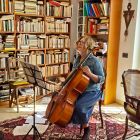Romanians drawn to the capital.
I came here to work, like all Romanians. The situation is difficult back home. What can I say? Ciodaru Barbus explanation for being in Rome could be that of any of the capitals 59,547 Romanians, who represent 20 per cent of all immigrants and are thus the largest foreign community in Rome. These latest figures apply to 2003 and are contained in this years dossier on immigration in Italy, produced by the Rome branch of the Roman Catholic relief organisation Caritas
The sharp increase from 2002 statistics, which reported 20,119 Romanians in the capital (an increase of just under 40,000 in one year), is believed to be due to the process of regolarizzazione or legalisation, which gave all illegal immigrants the opportunity to apply for the correct paperwork. One in five of the applicants was a Romanian national and as 90 per cent of all applications were accepted (to a total of 704,000), official numbers of Romanians in the city were bumped up overnight, says Antonio Ricci of the Rome branch of Caritas. The reality is that they were probably already here, he concludes. Although at present Italy has the largest number of Romanian immigrants in Europe (239,426), Spain is currently going through its own process of regolarizzazione and it is thought that when this is complete, results will show more Romanians in Spain than in Italy.
The average salary in Romania is 200 a month not enough, explains Barbu, from the countrys capital, Bucharest. Thats if you are lucky enough to find a job. Then comes the problem of keeping it. Its worse than in Italyit is all about who you know, he continues. In Rome, if you work hard, you can earn up to 900. Thats enough to pay rent, eat and send home more money than you would ever earn in Romania. I think fewer workers will come here when we join the European Union in 2007. Salaries will hopefully increase to at least 400-500 so there wont be such desperation to get out, he concludes.
Why is it that so many Romanians come to Italy rather than going to other European countries? Not only is Italy seen as quite easy and relatively cheap to reach from Romania (coaches currently depart from Stazione Tiburtina for Bucharest each day), but the national language has Latin origins Romania having been conquered and colonised by the Romans in the 2nd century BC and is therefore much closer to Italian than it is to the languages of its Slav neighbours.
Another factor that makes Italy more attractive is the image that it is easy to find work, especially manual labour. In 2004, immigrants working in Italy sent home around 2.1 million and, according to Caritas, as much as 60 per cent of this money was sent by immigrants living in and around Rome. Statistics showed that of all foreign communities it was the Romanians ahead of the Moroccans, Senegalese and Albanians who sent the most money back. Motives for being in the country are therefore, more often than not, based on expediency. In so far as staying here long-term is concerned, Barbu insists that he has no such plans. Oh no, home is home. Ill stay for another year or two, then Im definitely planning on going back, he confirms.
The downside of coming to the country with the intention of staying for only a short time as many do is that there is little incentive to settle down and many do not feel well integrated into Italian society. Much travelling backwards and forwards occurs known in Italian as pendolarismo (which probably means that the real number of nationals in the country is far higher than the official figures. The inclusion of Romanian Rom would also increase numbers considerably). If you only need to be in a place for a short period and you travel backwards and forwards, it is by nature quite a precarious lifestyle, itself an obstacle to integration, notes Ricci. Added to that is the fact that many Romanians work in nero or illegally an unstable existence with the constant risk of being found out and integration is harder than it initially appears.
In a sense there is less of a necessity to integrate in Rome as there are various points where the community gathers, thus giving rise to an expanding network and a greater support system. A milestone for the community in the capital was the election in spring 2004 of Romanian-born Gabriel Ionut Rusu as one of the four non-voting immigrant councillors elected to the Rome city government. This marked the establishment of an official voice not only for Romanians in the city but also for nationals from eastern European countries outside the European Union.
Large communities of Romanians gather around various churches of different denominations in Rome (see list below) such as the Romanian Orthodox church in Piazza S. Salvatore alle Coppelle, the Roman Catholic church of S. Maria in Campitelli, evangelical churches in Via del Teatro Valle and Via delle Spighe and the Waldesian Church in Via IV Novembre where a Romanian Seventh-Day Adventist community meets. There is also a support network in the guise of the Accademia di Romania a Roma present in the city since 1922. Earlier this year it was chosen to host the joint exhibition Spazi Aperti displaying the work of artists from all of Romes foreign cultural academies and institutes. The academy has an active cultural programme of exhibitions, concerts, conferences and round-table events. Moreover, it is not simply aimed at the needs of visiting scholars and artists. For example, on 3 December it will celebrate the Romanian national day with traditional food and music and it is already looking ahead to January when there will be various celebrations both at the academy and at the Campidoglio to mark 80 years of the Romanian language being taught in universities in Italy.
Ciodaru Barbu did not want us to publish his real name when he was interviewed at Rome Baptist Church so this one has been used instead.
Accademia di Romania a Roma, Piazza Jos de S. Martin, tel. 063201594. www.accadromania.it.
Chiesa di S. Maria in Campitelli, Piazza Campitelli 9 (historic centre).
Chiesa Ortodossa - Chiesa Nazionale Rumena) Piazza S. Salvatore alle Coppelle (historic centre).
Chiesa Cristiana Evangelica Battista Romena di Roma, Via del Teatro Valle 27 (historic centre).
Chiesa Evangelica Romena c/o Chiesa Evangelica internazionale,
Via G. Chiovenda 57 (Cinecitt).
Comunit Avventista Romena c/o Chiesa Valdese, Via IV Novembre 107 (historic centre).
Chiesa Evangelica Battista, Via delle Spighe 8 (Centocelle).





















